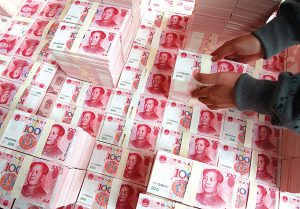
Bloomberg
China’s central bank has signalled a limit to its tolerance for the yuan’s recent advance by setting its reference rate at a weaker-than-expected level.
The gap between the daily fixing set by the People’s Bank of China (PBOC) and the forecast in a Bloomberg survey of analysts and traders was the largest since mid-October. That was when yuan gains accelerated on strong trade data
and hopes of easing tensions between China and the US.
The move illustrates Beijing’s wariness of rapid gains in the exchange rate given traders can unwind their long positions just as quickly. It comes after the yuan advanced to its strongest level against the dollar since May 2018, with confidence boosted by official signals of more easing to support the economy.
“The weaker-than-expected fix is a reminder to markets that the currency is being watched and the central bank wants to prevent appreciation bets from snowballing,†said Fiona Lim, a senior foreign-exchange strategist at Malayan Banking Berhad.
This year, the yuan has been supported by strong inflows given China’s robust exports and foreign investment in onshore bonds. The currency was more recently aided by bets that Beijing’s monetary stimulus will sustain the nation’s growth and that the new Covid-19 variant will have limited impact on the global recovery. The yuan is hovering near a six-year high versus a basket of trading partners.
The PBOC this week announced a cut to the amount of cash lenders need to set aside as reserves, suggesting Beijing is prioritising growth over crackdowns on the property sector and technology industry. Looser monetary policy can act as a double-edged sword for the exchange rate in the medium term. While flush liquidity supply benefits the yuan by aiding growth, it could also hurt foreign demand for the currency as it reduces China’s rate premium over the rest of the world.
The reserve-ratio cut and hopes for further easing have benefited Chinese stocks, which gained for a third straight day. Government bonds rebounded this week as traders bet more monetary stimulus could be
announced next year.
State-run media reiterated that the currency will continue to fluctuate both ways. The yuan could keep gaining against the greenback in the near-term due to strong exports, fund inflows and a stable monetary policy, China Securities Journal said in a front-page report, citing analysts.
Policy makers had previously been more hands-off in their approach to the rally, using only slightly weaker fixings and issuing prompts to traders about not making one-way bets. Other tools Beijing can use to manage the yuan include tightening the liquidity of dollars onshore — which was deployed once in June — and encouraging lenders to submit weaker quotes for the reference rate.
The PBOC set the fixing at 6.3498 per dollar, weaker than the average estimate of 6.3467. The fixing limits the yuan moves by 2% on either side. The onshore yuan was little changed at 6.3447 as of 2:30 p.m. in Shanghai, while the offshore yuan gained 0.1% to 6.3421.
“Further easing of monetary policy via liquidity injections or lowering of interest rates could help ameliorate the yuan’s strength at a time when the Federal Reserve is taking a hawkish turn,†said Joey Chew, senior Asia foreign-exchange strategist at HSBC Holdings Plc. “But the carry advantage will take time to narrow, as would the current account surplus.â€
 The Gulf Time Newspaper One of the finest business newspapers in the UAE brought to you by our professional writers and editors.
The Gulf Time Newspaper One of the finest business newspapers in the UAE brought to you by our professional writers and editors.